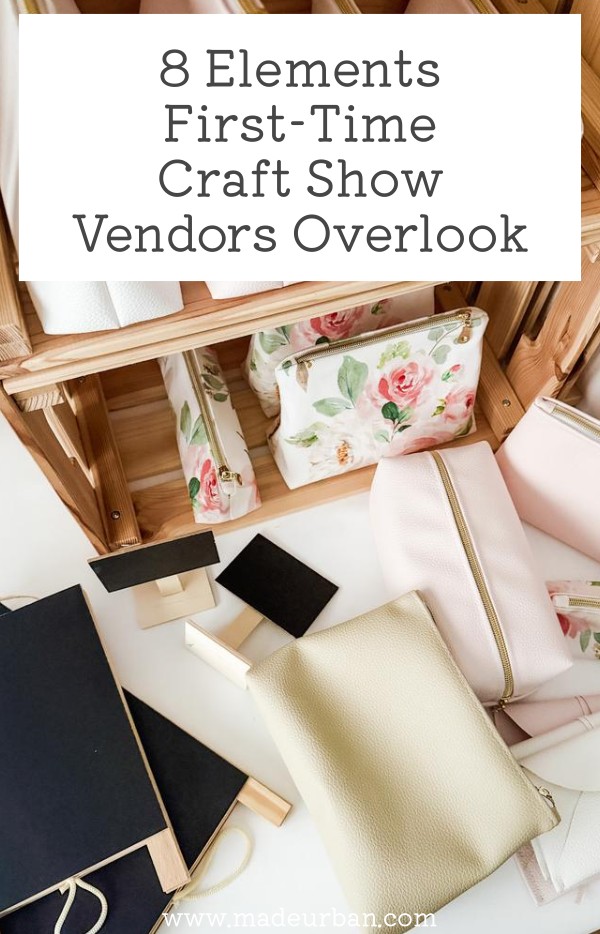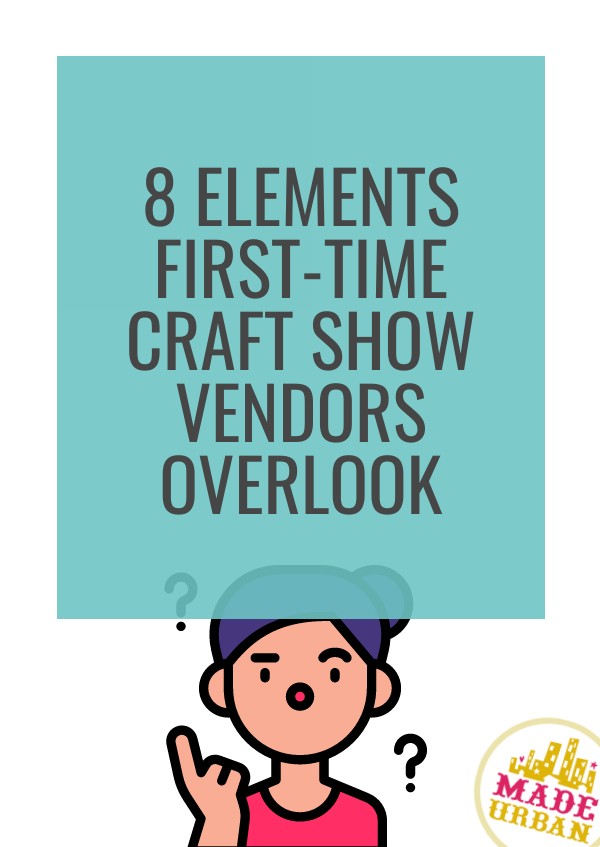8 Elements First-Time Craft Show Vendors Overlook
If you’re preparing for your very first craft show, you’re probably busy making products, planning your display, and figuring out how to take payments.
>> Here’s a checklist for some other things to think about for your first craft show
But there may be some things and details you don’t think about.
Every experienced vendor has a story about “that one show” when they forgot something important. Maybe it was a windy outdoor event and they didn’t have tent weights, or an indoor show with no outlets for their lights. Those lessons usually come the hard way.
The good news? You can skip a lot of those rookie mistakes.
Below is a list of the often-forgotten details and clever little things seasoned craft show vendors wish they’d known before their first event. From practical setup tools to smart comfort tips, this guide will help you feel prepared, confident, and ready to handle whatever the day throws at you.

1. Booth Logistics & Setup
- Power access isn’t guaranteed – Many first-timers assume they’ll be able to plug in lights or charge their phone — but outlets are often limited or cost extra. Bring battery-powered lights or a portable power bank.
- You might need your own table and chair – Some shows include them; others don’t. Always double-check what’s provided.
- Bring a table covering that reaches the floor – It hides bins and boxes under your table, giving your booth a cleaner, more professional look.
- Tape, zip ties, and clamps are lifesavers – Windy outdoor shows, uneven tables, or drooping banners can ruin your display if you’re not prepared.
- Bring weights for outdoor tents – Even light wind can lift an unweighted tent — and organizers may not let you set up without proper anchors.
- Weather-proof your setup – For outdoor shows, bring tarps, plastic bins, and extra towels to be prepared for rain. Also think about hot weather helpers (a fan (handheld, battery powered or electric), umbrella or tent walls for extra shade, etc.).
2. Display Details
- Signs at eye level – First-timers often put everything flat on the table, but signage and displays need height to catch attention.
- Prices on every item – Shoppers don’t want to ask. Missing prices = missed sales.
- Mirror for wearable items – Jewelry, scarves, hats — people want to see how things look on them.
- A clear “hook” or tagline – Something short and memorable that tells people what you sell and why it’s special (“Vegan travel bags for the conscious traveller”).
3. Sales & Transactions
- Test your payment reader before the show – You might need to update the software or ensure it works offline.
- Bring cash and small change – Many vendors forget to have a float. Aim for at least $100 in small bills and coins.
- Track your sales manually – Record what sells so you know which products are worth restocking. Here are some other stats to track: 7 Stats to Track at Craft Shows (to improve sales)
4. Comfort & Practicality
- Bring water and snacks – You often can’t leave your booth for hours, and food lines get long. And think “snacking”. Unless you have a helper, you won’t get a lunch break, so you’ll need to take small bites between shoppers.
- Wear layers and comfortable shoes – Temperature changes and long hours standing can take a toll. You may even bring an ergonomic mat.
- Have a plan for bathroom breaks – Coordinate with a nearby vendor to watch your booth for a minute. Or ask friends or family members to stop by and help so you can have quick breaks to eat, get some fresh air, or shop.
- Bring hand sanitizer and wipes – You’ll be handling money and likely won’t be able to run to the washroom to clean your hands before snacking, or clean your hands after eating.
- Pack sunscreen and bug spray – Outdoor shows can be brutal without them.
5. Marketing & Branding
- Business cards or postcards – First-timers often focus on selling today, forgetting that many buyers might want to shop later. Here are other marketing tactics to consider for craft shows.
- Email sign-up sheet or QR code – Don’t lose contact with interested shoppers — collect emails for future shows or online sales (here’s how).
- A small display of your social media or website – A printed sign with “Follow us on Instagram” or a QR code makes it easy for people to find you again.
- Tell your story – A simple printed card about your brand (“I started making these soaps because I couldn’t find gentle, fragrance-free options”) can make your booth more memorable.
6. During the Show
- Stand up — but not the whole time – You’ll appear more approachable when you’re on your feet, but take breaks so you’re not exhausted by midday.
- Stick to snacking – Try to snack discreetly. You don’t want a mouthful of food as you’re pitching your products to shoppers.
- Stay positive even if it’s slow – Other vendors are watching, and shoppers pick up on energy. A cheerful attitude attracts people. Here’s what to do if you’re at a slow event.
- Be ready for repetitive questions – You’ll hear “Did you make all this?” a dozen times. But it’s important to answer with enthusiasm every time.
7. After the Show
- Take notes immediately after – Jot down what sold, what didn’t, what people commented on, and what you forgot to bring. You’ll likely forget the little details if you don’t record them right away.
- Ask for feedback – Chat with nearby vendors as they’ll often share tips about other shows or what sells well in your category.
- Track your expenses – Booth fees, supplies, mileage, meals, etc., add up and are a business expense. To treat this like a business and to strive for profits, you’ll need to keep records to make sure your prices and sales are covering all costs.
- Follow up – Post photos from the event, thank people for coming, and email new subscribers.
8. Mindset Shifts
- Not every show is a big moneymaker — and that’s okay – Think of your first few shows as paid research and marketing experience (How Much Money Should you Make at your First Craft Show?).
- You’re representing your brand, not just selling products – Every interaction, even with non-buyers, builds awareness.
- It’s normal to forget things – You’ll refine your system with each show.
- Other vendors aren’t competitors — they’re your community – Networking is one of the best parts of craft shows.
Every craft show is a learning experience, and even the most seasoned vendors forget something now and then. The key is to go in prepared, stay flexible, and treat each event as practice for the next one. You’ll quickly build your own “can’t-forget” list and setup routine, and those nerves before show day will turn into excitement.
So if you’re a first-time vendor, take a deep breath, double-check your packing list, and remember: everyone starts somewhere. The more you show up, learn, and adjust, the smoother and more successful your shows will become.


Hey, I’m Erin 🙂 I write about small business and craft show techniques I’ve learned from being a small business owner for almost 2 decades, selling at dozens of craft shows, and earning a diploma in Visual Communication Design. I hope you find my advice helpful!
